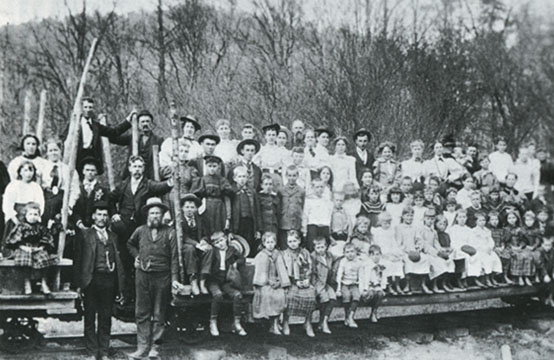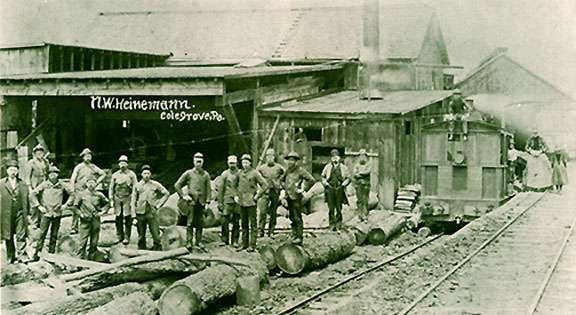Colegrove, Crosby & Beyond

Heinemann's July 4th , 1894 Train Excursion Norwich Township to Ridgway

|
June 29, 1894 page: 3 column: 6 "On the Fourth of July next N. W. Heinemann will give a free excurtion on his railroad to the "Ridgway Lot" to all the present and former residents of Norwich Township.A program of singing and speaking will be arranged, and Mrs. A. P. Brewer will give a historical address on the place. All are requested to bring such eatables as they prefer and to put them. Trains will run at 10 a. m. and at 1 p. m." |
| Mr. Heinemann
became very wealthy on his own, and the increase of income never changed
who he was.
His granddaughter, Julia Belle Gallup best described him as: "Mr. Heinemann was a quiet man, firm and unpretentious, whose main interest was his work. His mode of living was simple. Early to bed, early to rise, eating plain foods, dressing for comfort and never for style, this was his way. His work was seven days the year around, leaving no time for leisure. Because he asked his workmen to do no job he wouldn't do himself, he earned their respect and loyalty. " He bought an automobile but never drove. The car was used by Mrs. Heinemann chauffeured by Herman Lord. The auto could never replace his horse 'Dock'." You could always find Mr. Heinemann in the woods or working on his railroad. Although the chemical company carried his name and he was apart owner, he never got involved. He owned the sawmill and let others run it. His interest lay in the fourteen thousand acres he gradually bought running southeast from Crosby to Parker Run. He probably knew every acre of it. He hunted for coal which was not successful, he hunted for gas and located wells which was very successful, and he supervised the cutting of his saw timber and chemical wood. He spent all his money expanding his property. During one purchase, he paid his employees and then asked them to loan it back. They agreed, and he arranged for them to have a charge at Charlie Anderson's Colegrove store. In a few months the employees were paid back. All Heinemann's land was purchased to be adjacent to land already owned. It had a railroad built through all of it except 750 acres on the west side of Potato Creek, which the timber was brought in by sled. Heinemann was born in Germany in 1848. Three years later his family moved to the U.S. and settled about a mile south of Colegrove. His father had a farmer and an up-and-down sawmill, which heinemann worked on and eventually took over. He expanded the mill and moved it closer to his homestead, which is now the Maples Inn. In December 1917, shortly before his death, Mr. Heinemann retired due to poor health. Charles M. Benson, his woods superintendent, and William H. Gallup, his son-in-law, were named the trustees of Mr. Heinemann's estate. When Benson passed away Gallup became sole trustee. The estate included the land holdings, railroad, sawmill, and partial ownership of the chemical plant. The estate continued until 1959 when it was terminated and the remaining land was sold to the Hammermill Paper Company. William Gallup, the managing trustee, had married Theresa Heinemann and learned the lumber business from the bottom up. Gallup involved himself mostly in the gas operations. The market for lumber had virtually disappeared. The decision was made to close the mill. The sawmill may have been closed shortly before the railroad, which was torn up about 1931 or 32 after forty years use. The chemical plant operated on a reduced scale, usually losing money. The company was declared bankrupt on October 19, 1940. Chester L. Burt, manager of the company, was named trustee. Four weeks later, on November 15th, it was sold at auction for $14,000 to Mr. Gallup representing the Heinemann Estate. Operations continued through World War II, and in February 1946 was sold to the Susquehanna Chemical Company. A year after selling, William Gallup unexpectedly died. Albert Huff was named foreman to run the plant. Susquehanna paid him $200 a month during the three years of sporadic operation which followed. In the fall of 1949 it finally closed permanently. At the time of closing, many of the employees had worked there a long tie. Other employees had died or retired or gone to work in the higher paying gas fields. Peter Pettenati and George Smith worked 33 and 35 years respectively in the still house. Bert Snyder and Louis Cappoletti were boiler firemen. Paul and Andy Widert were on the retorts. Earl Manwarren was plant foreman. Charles Billings, Tony Simon, and George Pete were on the kiln. Andy Bond and Andy and Mike Gurnot worked the wood yard. Martin Straights, Bill Cunningham, and Forest Morey were on maintenance. Sam Hendrickson and Bob Cooper ran the plant at different times. The charcoal crew included Henry Elsworth and Cottie Lathrop, John Walters, Claire Cooney, Angelo and Hector Simonetti, John, Pete, and Batisa Rossi. Roy winslow was the first bookkeeper, followed after his death by C. L. Burt and Vera Conley.
|
go to Nicholas Heinemann Empire

Facts and photos gathered from:
Sawmills Among the Derricks, Thomas T. Taber, III, 1975, Book
No. 7 in the series, Logging Railroad Era of Lumbering in Pennsylvania
Click here
to learn about the Wood Chemical Industry
Click here
to return to Crosby